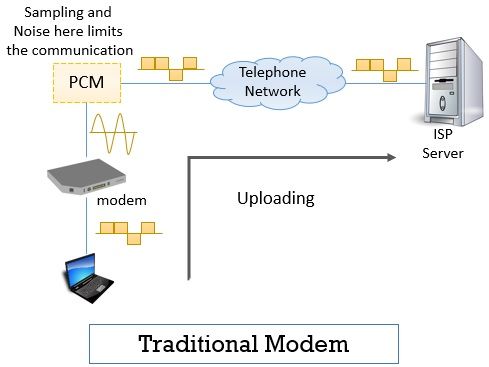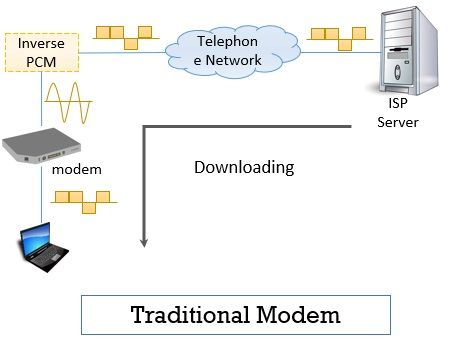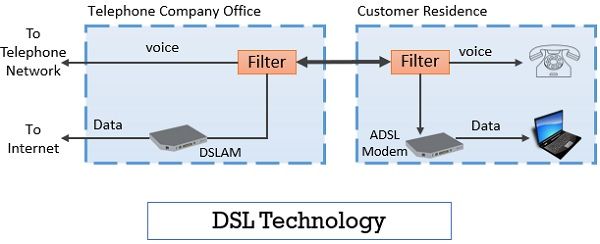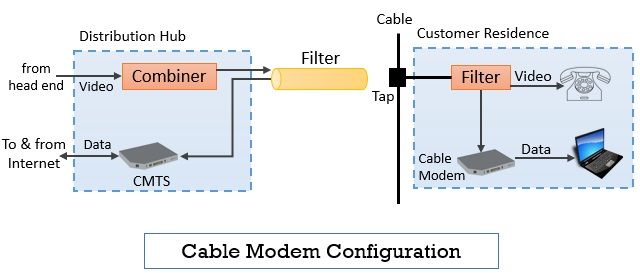The point-to-point WAN is a kind of network that establishes a connection between two remote devices using a leased line that is meant for public networks such as telephone lines. In this section, we will discuss the technologies that are used to create a point-to-point WAN network.
Point-to-Point WAN Technologies
Traditional Modem
The traditional modems are still used to upload or download data from the internet. The maximum speed of uploading data using a traditional modem is 33.6 kbps and the maximum downloading speed from the internet is 56 kbps.

Now you might think why the uploading data rate is less as compared to downloading data rate? This is because while uploading the analog signal it is sampled and this put limitation over the uploading data rate. However, sampling is not required during the downloading which increases the downloading data rate.

The modem V.90 and V.92 are the traditional modem which has a data transfer rate of 56kbps.
DSL Technology
To improve the data transfer rates, telephone companies came up with a new technology DSL i.e., Digital Subscriber Line. DSL is a set of technologies that provide high-speed digital communication through the local telephone line.
The DSL set is represented as xDSL where x can be A, V, H, or S.
1. ADSL (Asymmetric Digital Subscriber Line)
The term asymmetric refers to the difference in data transfer rates during the uploading and downloading. This technique is similar to the traditional modem as ADSL also provides a high transfer rate during downloading and a lower transfer rate during uploading.
The ADSL technology is ideal for the users who download more as compared to upload and usually, these are the residential customers. So, ADSL technology is suitable for residential users but not for business users.
The business user needs to send and receive a large volume of data. So, we require a technology that provides high-speed transmission while uploading as well as downloading. The uploading speed in ADSL is 64 kbps to 1 Mbps and the downloading speed is 500 kbps to 8 Mbps.
Now let us see how it works, the ADSL modem is installed at the user end. To one end of the ADSL modem, the user connects his devices to access data. And one end of the ADSL modem is connected to the filter which separates the data and voice coming from the telephone line.

2. SDSL (Symmetric Digital Subscriber Line)
The symmetrical digital subscriber line divides the available bandwidth equally for uploading and downloading streams. The SDL technology is suitable for business users who need to transmit a large volume of data.
3. HDSL (High bit-rate Digital Subscriber Line)
The HDSL transmits and receives a large volume of data. In HDSL technology the available bandwidth is divided uniformly between upstream and downstream. It was introduced as an alternative for T carrier line T1.
4. VDSL (Very high bit-rate Digital Subscriber Line)
The VDSL technology transmits data at faster rates. It is similar to ADSL in the sense that it has a larger downloading speed as compared to uploading speed.
Cable Modem
The conventional cable modem transforms the analog signal from the telephone line to the digital signal and vice versa, similar to the DSL modem. But cable modem is comparatively a complex device. The DSL technology uses the traditional telephone line for data transmission which is prone to interference.
The cable modem uses the cable TV line to connect your computer to the internet service provider (ISP). The cable line transmits the broadcasted video signals to the subscriber’s site.
A community antenna is set up at the top of the hill or at the top of the building which is also referred to as head-end or a cable TV office. This antenna receives the video signals from the TV stations and distributes these signals to the subscriber using the coaxial cables.

The traditional coaxial cable was susceptible to attenuation which requires the use of a large number of amplifiers. This leads to only one-way transmission i.e., from the head end to the subscriber’s site.
HFC Network (Hybrid Fibre Coaxial Network)
To enhance the capabilities of traditional cable networks the second-generation cable network was introduced which is a hybrid fiber-coaxial network. The partial network is implemented using fiber optic cable and the rest is implemented using the coaxial cable.
As above we have seen that the cable TV office that is the head end receives the broadcasted signals. Now from this head end to a node called fiber node the signals are transmitted using fiber optic cable. And from the fiber node to the subscribers the signal is still transmitted using coaxial cable.
This HFC network provides two-way communication from the subscriber’s end to the head-end and from the head-end to the subscriber end. The bandwidth of the coaxial cable of the HFC network is divided into three bands video band, data upstream band, and data downstream band.
The video band is always a downstream band that forwards the broadcasted video signals to the subscriber end. The data downstream band forwards the requested video, audio content, or any other information from the internet. The data upstream band carries requests for internet traffic from subscribers ends to the fiber note.
Now let us see the working of the cable network.
The cable modem is installed at the subscriber’s end which is connected to the Filter which filters out the broadcasted video signals for your TV and internet traffic for your computer.
At the distribution hub, a cable modem transmission system (CMTS) is installed which receives the internet traffic from the internet and sends it to the combiner. The combiner combines the broadcasted video signal and internet data to pass on to the subscribe. The CMTS also accepts data traffic from the subscriber and uploads it to the internet.
T Carrier Lines
T carrier lines are the digital telephone lines that transmit can transmit data and voice at a high speed. These T carrier lines are used to establish a physical link between the nodes in the network. The T carrier lines are the costlier option as they create a dedicated link between nodes in the network.
These T lines have 2 commercial versions T1 and T3. T1 carrier line has a data rate of 1.544 Mbps. T2 carrier line has a data rate of 44.736 Mbps.
SONET
The synchronous optical network (SONET) is a set of standards that define synchronous data transmission over a high bandwidth optic cable. With this technology, multiple digital data streams are transmitted over the fiber optic cable at once.
At first the set of electrical signals which are also referred to as synchronous transport signals (STSs) that are multiplexed and then converted to optical signals referred to as optical carriers (OCs). These optical signals are then transmitted to the receiver end. At the receiver end, the optical signals are converted back to an electrical signal and are demultiplexed to form separate digital signals.
PPP
Point to point protocol (PPP) was designed to manage the transfer of data using telephone lines or cable lines. Using this protocol a single user can be connected to the internet through a telephone line and standard modem. This point-to-point protocol defines only the first two layers of the OSI model i.e., the physical layer and the data link layer.
With point-to-point protocol, there are no specifications about the physical layer, the implementer can use whatever is available to him. When PPP is handling the link, it uses Link Control Protocol (LCP). The link control protocol is used to establish the link between the nodes, maintain the link and terminate the link when communication is over between the nodes in the network. To control the data transmission between different network protocols, PPP makes use of network control protocol (NCP).
So, this is all about the point-to-point WAN which connects two remote nodes. We have also discussed the techniques which can be used to implement the point-to-point WAN.

Leave a Reply